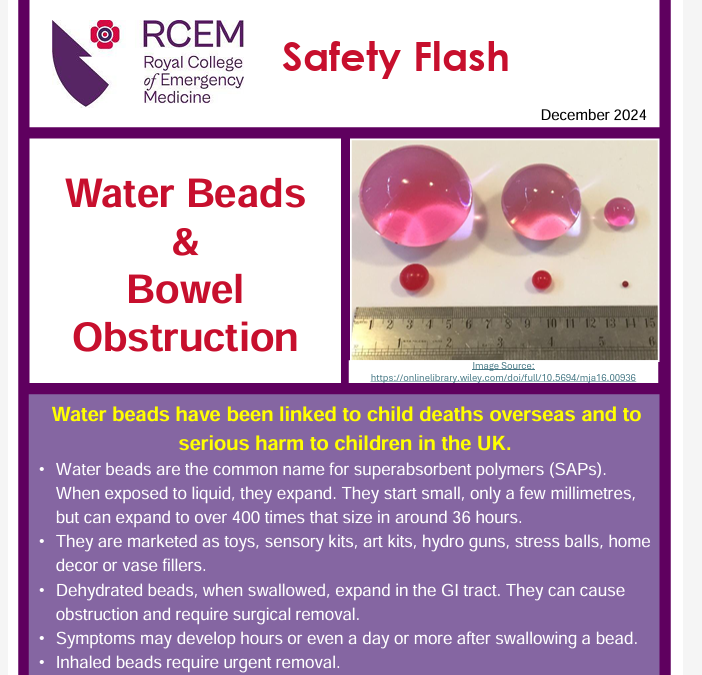
An Expert Witness With No Regard For Practice Direction Or The Perils Involved In ‘Cut And Paste’ Style Report Writing
19th February 2025
The Hidden Dangers of Falls: The Health Implications of Being Left Unassisted
25th March 2025Water beads, also known as hydrogel beads or superabsorbent polymer beads, are small, water-absorbing polymers that can expand up to 200 times their original size when exposed to moisture. Initially designed for agricultural purposes to retain soil moisture, these beads have found their way into consumer markets as children’s toys, decorative items, and sensory tools. While they offer tactile engagement and visual appeal, their potential for causing harm, particularly among children, has become a growing concern in the medical community.
Mechanism of Harm
The primary danger associated with water beads stems from their capacity to absorb water and expand significantly. When ingested, these beads can continue to swell within the gastrointestinal (GI) tract, leading to obstructions. Such obstructions can manifest as abdominal pain, vomiting, and, in severe cases, perforation of the intestinal wall. The radiolucent nature of these beads makes them challenging to detect using standard radiographic imaging, often delaying diagnosis and intervention. A case reported in Pediatrics highlighted an instance where a child developed intestinal obstruction and exhibited signs of neurotoxicity following the ingestion of water beads.
Epidemiological Data
Recent studies have highlighted an alarming increase in water bead-related injuries. An analysis by the Center for Injury Research and Policy at Nationwide Children’s Hospital revealed that from 2007 through 2022, there were over 8,000 emergency department visits in the United States associated with water beads. Notably, there was a 130% increase in such incidents from 2021 to 2022. Children under the age of five were particularly vulnerable, accounting for more than half of these cases. The majority of incidents involved ingestion (46%), followed by insertion into the ear (33%) or nose (12%), and ocular exposure (9%).
In the United Kingdom, concerns regarding water bead-related injuries have prompted official warnings and safety alerts. The Office for Product Safety and Standards (OPSS) issued a Product Safety Alert in September 2024, highlighting that water beads can pose serious risks, including gastrointestinal blockages requiring surgery and asphyxiation hazards. The alert emphasized that these products should be kept away from young children under five years of age and used only under close supervision with older children or vulnerable adults.
Medical professionals in the UK have also raised alarms about the dangers of water beads. In December 2024, leading emergency medicine clinicians urged parents and carers to exercise caution with toys containing water beads, especially during the festive season. They warned that ingestion of these beads could result in critical illness and necessitate emergency medical treatment.
Clinical Manifestations
The clinical presentation following water bead ingestion varies based on the location and extent of the obstruction:
- Oesophageal Obstruction: Symptoms may include drooling, dysphagia, and respiratory distress.
- Gastric Obstruction: Patients might present with persistent vomiting, abdominal distension, and discomfort.
- Intestinal Obstruction: This can lead to severe abdominal pain, bloating, constipation, and vomiting.
Diagnostic Challenges
The radiolucency of water beads poses significant diagnostic challenges. Traditional X-rays may not detect these foreign bodies, leading to potential delays in diagnosis. Advanced imaging modalities, such as ultrasound or computed tomography (CT) scans, are often required for accurate identification.
Management and Treatment
The approach to managing water bead ingestion depends on the location and severity of the obstruction:
- Conservative Management: In cases where the beads have passed into the intestines without causing complete obstruction, patients may be managed with close monitoring, hydration, and laxatives to facilitate passage.
- Endoscopic Removal: Beads located in the esophagus or stomach can often be retrieved endoscopically. Early intervention is crucial to prevent further migration and potential complications.
- Surgical Intervention: For beads causing significant obstruction, perforation, or when endoscopic removal is unsuccessful, surgical intervention may be necessary.
Conclusion
While water beads may offer sensory stimulation and decorative appeal, their potential to cause significant harm, especially among young children, cannot be overlooked. The public alerts and warnings underscore the potential hazards associated with their use. The medical community must remain vigilant in recognizing the symptoms associated with water bead ingestion and employ appropriate diagnostic and therapeutic interventions. Simultaneously, public education and regulatory measures are essential to mitigate the risks and prevent future incidents.




